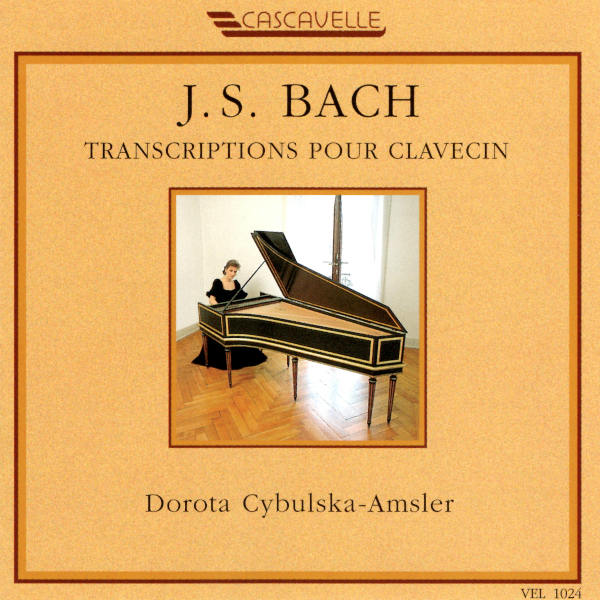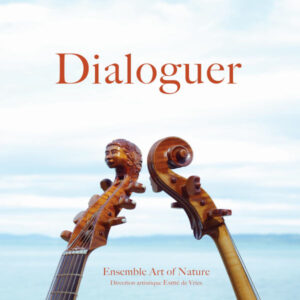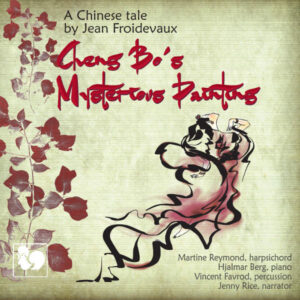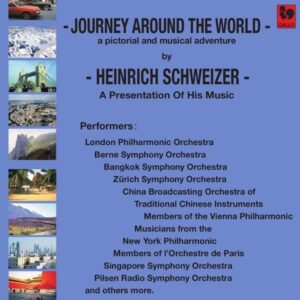Extraits / Excerpts
Johann Sebastian Bach: Transcriptions for Harpsichord - Dorota Cybulska-Amsler, Harpsichord
Johann Sebastian BACH: Keyboard Sonata in D Minor, BWV 964 – Prelude, Fugue and Allegro in E-Flat Major, BWV 998 – Suite in E Minor, BWV 996 – Sonata in A Minor, BWV 965 – Concerto in B Minor, BWV 979.
Dorota Cybulska-Amsler, Harpsichord.
J.S. BACH: TRANSCRIPTIONS FOR HARPSICHORD
The practice of transcription in its highly diverse manifestations constitutes an important chapter in the history of music. In that connection, keyboard music offers a rich palette of arrangements, from the “tablatures” of the 16th century up to Liszt’s arrangements for piano of the Beethoven symphonies. Liszt is traditionally designated as the father of the term “transcription” in its current usage of a piece adapted for presentation by a means different from that originally contemplated.
Harpsichord literature is rich in examples of that practice. One meets pieces of chamber music arranged for the harpsichord (such as Rameau’s “Pièces de clavecin en concert” or Anglebert’s arrangements of Lully’s orchestral works) as well as pieces for harpsichord which, with the approval of the composer, can be played on a melodic instrument with harpsichord accompaniment (such as, for example, certain pieces by Couperin).
Transcriptions represent a not negligible portion of the works of Johann Sebastian Bach. Their number includes not less than sixteen concertos of foreign masters transcribed for harpsichord, and five for organ. To which should be added, in chamber music, his transcriptions for harpsichord of his own works as well as those of other composers such as Albinoni, Corelli, Vivaldi, Reincken, etc., without taking into account the innumerable “migrations” of fragments from one work to another, using various techniques of adaptation (simple transcription, elaboration with addition or elimination of parts, change of key, rewriting pre-existing material to form a new work).
The Sonata in D Minor (BWV 964) is an arrangement of the Sonata in A Minor for solo violin (BWV 1003). This is born out by a single manuscript, found in a batch of Bach’s works copied by his pupil Altnickol. The title of the piece “Sonata / per il / cembalo solo / del Sgr. J.S. Bach” was inscribed not by Altnickol but by J.G. Müthel.[show_more more=”Show More” less=”Show Less”]
Johann Gottfried Müthel, organist in Riga, went to Leipzig in 1750 to improve his technique studying with Bach. After the death of the cantor, he stayed with Altnickol in Naumberg. It was probably then that Müthel came into possession of the score which belonged to Altnickol. This second hand title does not permit us to know with certainty whether Altnickol merely copied an arrangement made by Bach or whether he himself did the arrangement.
However, there exist other autograph transcriptions for other instruments of works for violin. For example, Bach adapted the 3rd Partita in E Major (BWV 1006) for an unspecified keyboard instrument (BWV 1006a), and the fugue from the 1st Sonata in G Minor (BWV 1001) for lute (BWV 1000) and for organ (BWV 539). Finally, in 1775, J.F. Agricola stated, in connection with the violin sonatas of his teacher Bach, that “their composer often played them on the clavichord, adding as much harmony as he considered useful”.
Prelude, Fugue and Allegro (BWV 998). The title of the autograph score stipulates “For lute or harpsichord”. If the attributed period of composition of 1740-45 — which has been questioned — is correct, that work would be one of Bach’s last compositions for lute. The fugue is one of the many versions of the choral “Vom Himmel hoch, da komm ich her” which Bach left.
Suite in E Minor (BWV 996). There exist several contemporary copies (in A or E Minor) of which the most important, dating from Bach’s lifetime, comes from J.G. Walther. The title of that manuscript is “Praeludio con la suite da Giov. Bast. Bach aufs Lauten Werk”, which indicates that it was to be performed not on the lute but on the “Lautenclavicymbel”, the lute-harpsichord. We do not possess any original of that strange instrument, nor even a pictorial representation; however, the inventory of Bach’s property established after his death lists two of them. J. Adlung, a respected musicologist, reports having heard one in 1740 that was constructed by Zacharias Hildebrant on Bach’s advice.
The Sonata in A Minor in the manner of Reincken (BWV 965) is an arrangement of the 1st Sonata of “Hortus musicus / recentibus alique fosculis / Sonaten / allemanden / couranten / sarabanden / et guigen / cum 2 violin, viola et basso continuo” (Hamburg 1687) of J.A. Reincken.
Johann Adam Reincken (1623-1722) was the celebrated organist of the Katharinenkirche in Hamburg. Bach repeatedly came from Luneberg to hear him. Around 1722, Bach came to Hamburg where he played before a circle of important persons. After having heard Bach improvise during nearly a half hour on the choral “An Wasserflüssen Babylons” Reincken, then nearly 100 years old, complimented him: “I thought that that art was dead, but I see that it continues with you”.
Reincken is one of the masters cited by J.N. Forkel whom Bach studied with the greatest attention. It can therefore be said that the transcription by Bach of the two sonatas of Reincken constitutes a sort of homage of Bach to the older master.
The structure of the Reincken sonatas is Adagio – Allegro – Adagio – Allegro, followed by dances. In the present case, and particularly in the fugue of the second movement, the term “transcription” imperfectly reflects the work of the cantor. Bach more or less rewrote the work, using the thematic material of the original, but adding combinations of the theme with counter-subjects which are in turn developed, thus producing a larger and more charming work than the original on which it is based. Reincken’s fugue, for example, is made of 50 bars, while Bach’s has 85. In the gigue (39 bars against 50) Bach introduces “divertimenti” and a fourth voice. It is no exaggeration to conclude that Bach improved the musical quality of the original.
The Concerto in B Minor for Harpsichord (BWV 979) is an arrangement of a concerto for violin of Torelli (according to the Viennese manuscript) or Vivaldi (according to the manuscript of Lund). The arrangement for harpsichord bears the title “XII concerto di Vivaldi elaborati di J.S. Bach”. In the past it was believed that Bach interested himself in the work of Vivaldi in order to familiarize himself with the concerto form, and that the transcriptions were mere technical exercises. However, recent researches have shown that Bach could have been asked to prepare these arrangements by the young Duke of Saxe-Weimar, Jean Ernest, who was an excellent harpsichordist.
[/show_more]
- Categories
- Composers
- Interprets
- Booklet












